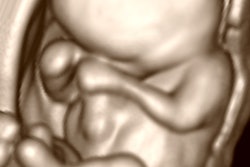
AuntMinnie.com presents the second in a series of columns on the practice of ultrasound from Dr. Jason Birnholz, an ultrasound veteran with more than 40 years of experience in this field.
Fellow UltraSounder,
Period problems are or should be one of the leading indications for pelvic ultrasound. A lot of gynecologists tend to have a set pattern of oral contraceptive use for a few cycles followed by endometrial biopsy and dilation and curettage (D&C) or ablation without resorting to ultrasound at all, and to be fair, a lot of ultrasound facilities do not pay a lot attention to endometrial dynamics and myometrial blood flow, which are themes of this column.
 |
| Dr. Jason Birnholz. |
To women during the childbearing years, menstruation refers to flow, the shedding of the functional layer of the endometrium, which can be heavier or lighter than average, vary in timing of peak flow, or occupy a few or very many days in extent. Menorrhagia is the term for abnormally heavy or prolonged flow, and, of course, dysmenorrhea means painful menstruation.
Seeing new things
When you upgrade equipment, it is a worthwhile exercise to try to see something you have not seen before. In the early 1980s, I had the pleasure of using the serial No. 1 Acuson 128 system for routine exams. One of the many revolutionary features of that device was "write" magnification. With "read" magnification, a portion of a stored image is enlarged. The inherent resolution of the original image and magnified segment are the same. However, with write magnification, the array scans just the region of interest, and those data are distributed over the full display matrix.
The ratio of tissue area to pixels is greatly improved, i.e., resolution is better; you see more. I routinely magnified transabdominal images of the uterine body and fundus, and because of the improved temporal resolution of this system, I was able to see stripping movements in the endometrial border zone along with phasic changes in the reflectivity and continuity of the opposed central endometrial cavity margins. Motion was most evident at midcycle, when they appeared to be coordinated into a series of retrograde waves. I reported this along with a series of women with unexplained infertility in whom there were no organized retrograde movements.
The presumption was that movements were related to estrogen level. Of course, nothing in the body is ever that simple, although it makes for an easy way to model the observations. Besides hormone production, the final physiologic effect is influenced by carrier proteins; the presence, density, and availability of receptors; the presence of antagonists (such as progesterone); and the intracellular mechanism by which activated receptors convey signals to the cell nucleus to activate or deactivate some block of genetic code.
I became curious about the mechanism of menstruation when overall image quality was improved and endovaginal probes became available toward the end of the 1980s. I requested that patients referred for gynecologic issues come in some time during menstruation, and it was relatively easy to observe contractions in the inner zone of the myometrium and repetitive squeezing of the endometrium.
The initial impressions were that that menstruation requires and is the result of contractions (there is no passive flow) and that the length of menstruation depends on the coordination (or pump efficiency) of contractions, being of longer duration when contractions are chaotic. With retrograde stripping movements, menstruum may be ejected into the tubes with free fluid appearing in the cul de sac, which is the classic theory of the origin of endometriosis. And, painful periods are accompanied by very forceful, visibly prominent contractions.
One of the ways of thinking about the uterus is as a one-chamber pump in which pacemakers are induced (by estrogen), one of which probably becomes a dominant center for electromechanical transduction. The mechanism for menstruation is identical to the uterine emptying of a miscarriage, which is delayed by the administration of progesterone, an estrogen antagonist.
Adding to the complexity of the molecular interactions is that there are isoforms of progesterone and there are progesterone receptors for intracellular signaling, which themselves have multiple forms and haplotypes with many sources of extrinsic modulation. High-resolution, high-speed ultrasound provides a way of observing the mechanical events that occur with menstruation and which are a common factor in all causes of pathological vaginal bleeding.
Vaginal bleeding
I have tried to keep menstruation and vaginal bleeding separated as terms, although patients cannot distinguish the two conditions. For example, the peri- or postmenopausal woman with intermittent vaginal bleeding from a polyp may assume that the change has not yet happened. There is, normally, iron conservation and relatively little blood loss with menstruation.
Women with clotting disorders may pass clots or develop anemia from normal periods, but most of the time, when there is unexplained iron deficiency in a menstruating woman or flow is continuous, prolonged, or persistently heavy, gynecologists tend to wonder about the possibility of anatomic causes of bleeding, such as a polyp or, more significantly, an endometrial cancer.
"Energy" Doppler, more commonly known today as power Doppler, was introduced a few years after endovaginal probes, during a time when there was a lot of work on dynamic beam formation and elaborate forms of signal processing for improved image quality. I prefer the "energy" Doppler name because processing uses the (numerical) square of the velocity. This makes it a more exact description than power Doppler, which has become the popular term.
One of the common stories related by women in their 40s is that after a few term pregnancies (possibly two, but especially with four or more), periods become shorter in duration and much more intense, with lots of flow on the second day and relatively little afterward. There is often passage of dark brown semisolid material, which is a mixture of sheets of endometrial tissue and clotted blood. Cramps are typical and at times are quite painful.
During menstruation, the endometrium is thin and there is serosanguinous fluid in the endometrial cavity. The myometrium tends to be thick, contractions are forceful, and the myometrium lights up like a light bulb in energy Doppler images because of diffusely increased vascularity and blood flow. The pattern is typically pulsatile in the midzone of the myometrium and more constant peripherally and centrally because of the pattern of venous drainage of the uterus. With the uterine myometrium tending to resemble a giant black and blue mark, it is not surprising that dysmenorrhea is often the presenting complaint with menorrhagia being elicited during history taking.
Adenomyosis
We have tended to report the hypervascular myometrium as "adenomyosis" to make the clinical picture easily comprehensible to our referring physicians. The menstrual pattern is typical of what is described in the literature as adenomyosis, which rarely has tissue confirmation. In addition, these cases have excessive bleeding with D&Cs, which those same referring physicians need to know for management planning.
The traditional concept of adenomyosis is that something (such as the mechanical stresses of repeated labors) breaks down the barrier between the basal layer of the endometrium and the surrounding myometrium, enabling endometrial cells to migrate into the myometrium where they proliferate. Gland tissue is quite vascular, hence the Doppler findings. Adenomyosis and hypervascularity can also be seen in nulliparous women, albeit much less frequently than in multiparas in their 40s.
More exacting signs of adenomyosis are an irregular outer border of the basal layer and multiple small cysts, varying in size and location. Focal adenomyosis is identified as discrete nodules (adenomyomas) that are distinguished from leiomyomas (fibroids) in that the former are diffusely vascular while the latter have marginal vascularity.
I think it is probable that myometrial hypervascularity is a primary uterine abnormality that could not have been identified prior to the availability of endovaginal 2D Doppler. It is of interest that some necessarily limited angiographic studies of women with infertility attributed to implantation failures have had a diffuse increase in vascularity. I expect that the clinical nature of this finding will be clarified when endovaginal Doppler is a routine part of each gynecological exam and when we begin to pool our observations of many patients merged from all of our collective experiences, rather than the typical piecemeal reports of perhaps 50 to 500 patients at one center.
Fibroids
I have left the topic of fibroids for last because this has been a perennial source of clinical misdirection for ages. Fibroids have a high prevalence, and larger ones are easy to identify by bimanual exam. It is no surprise that over the years, everything has been blamed on fibroids, when they are typically comorbid factors.
Fibroids expand when estrogen is elevated, such as early and midpregnancy, and they often grow to palpable size during the estrogen surges of perimenopause. I hate study requests for menorrhagia that say something like "R/O fibroid," because that implies that the referrer has no idea of the role of ultrasound beyond 1970s B-mode imaging, and it conveys a message that the facility fielding the request is perceived to be equally limited in its capabilities.
Fibroids are thought of loosely and probably incorrectly as neoplasms, which would make them the most common tumors in the body. As is well known, their prevalence is about three times higher in African-American women than in other ethnic groups. A fascinating study of myofibroblast gene expression reported by Leppert, Catherino, and Segars (American Journal of Obstetrics and Gynecology, August 2006, Vol. 195:2, pp. 415-420) suggested that fibroids and keloids share a lot of molecular genetic features, and that perhaps fibroids result from disordered healing, presumably initiated by some focal trauma, infection, infarction, or immune process. That is not to say that a small percentage of fibroids may have genetic instability with the potential for mutational events predisposing to true neoplastic transformation.
Submucous fibroids may be associated with vaginal bleeding. Leiomyomas have centripetal venous drainage with a rim of distended vessels. Erosion of an edge of a fibroid into the endometrium creates a localized bleeding point with spotting occurring as contractions force migration of blood to and through the endocervical canal.
Most fibroids are intramural or subserosal. A small subset of fibroids secretes substances (such as epidermal growth factor I) that radically increase local blood flow, promoting their potential growth. In this case, the tissue intervening between the fibroids will have the hypervascular pattern described above, equally well identified by endovaginal Doppler ultrasound, contrast x-ray, or MRI angiography. The hypervascularity and fibroids are perhaps most expeditiously treated by embolization, assuming that there is no separate perceived risk of uterine cancer, although this remains to be established.
In summary, it is our belief that ultrasound imaging be used at the start of an evaluation for menstrual symptoms. That evaluation should utilize high-resolution endovaginal imaging and 2D Doppler. Finally, the ultrasound operator will function best by utilizing those tools with sound mental models of the mechanics of menstruation and vaginal bleeding and a practical familiarity with uterine pathology and pathophysiology.
Dr. Jason Birnholz is a graduate of Johns Hopkins School of Medicine and did his diagnostic radiology residency at Massachusetts General Hospital. He was awarded an advanced academic fellowship from the James Picker Foundation and has been a professor of radiology.
The comments and observations expressed herein do not necessarily reflect the opinions of AuntMinnie.com, nor should they be construed as an endorsement or admonishment of any particular vendor, analyst, industry consultant, or consulting group.



















